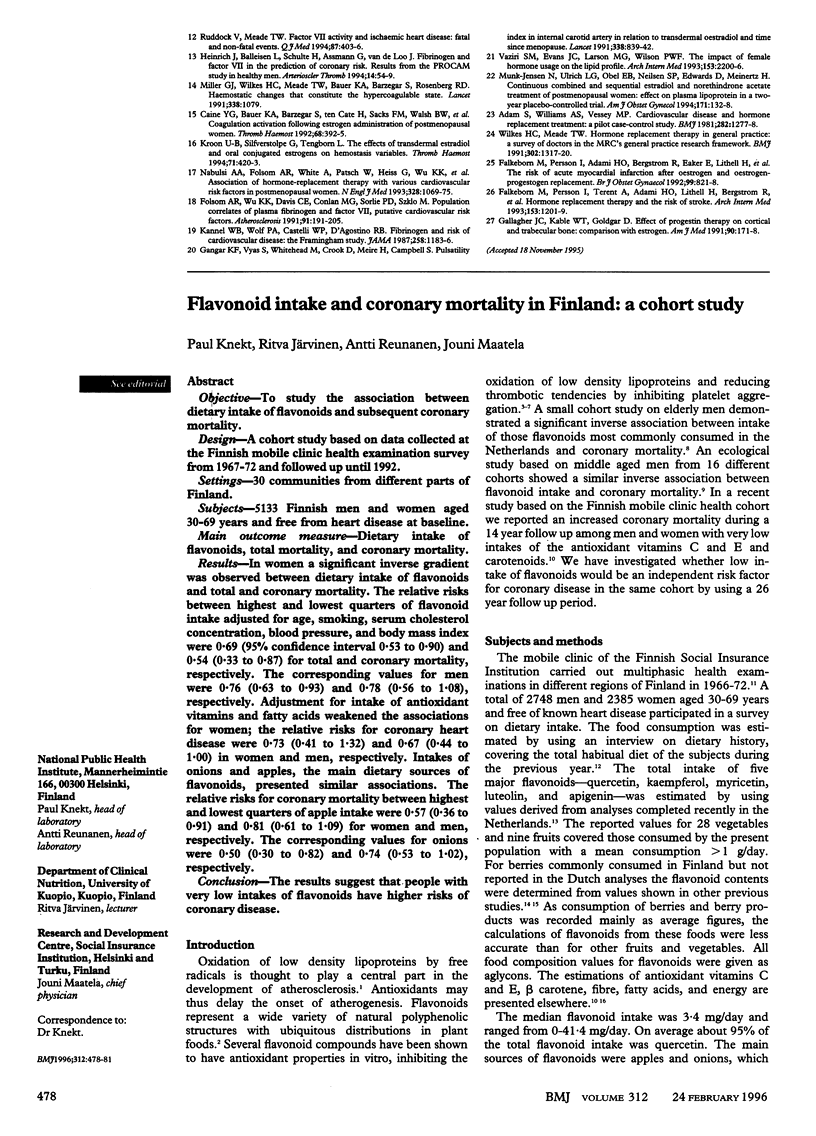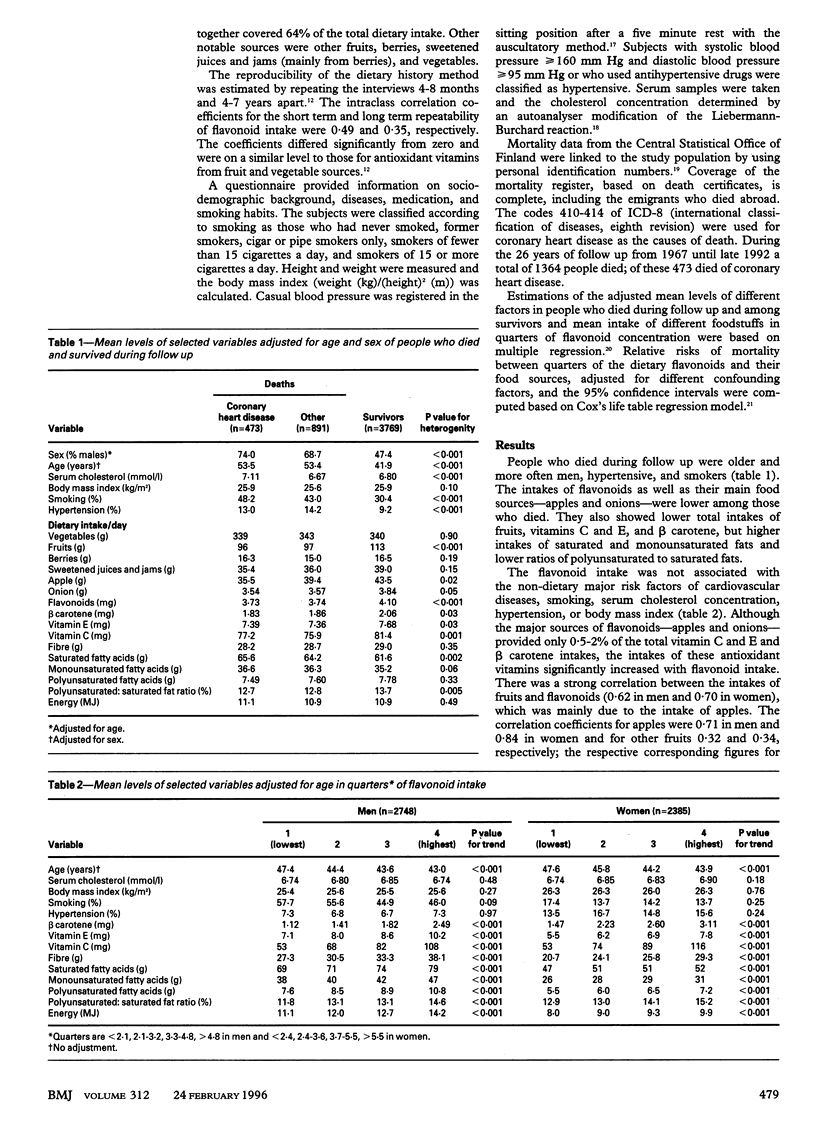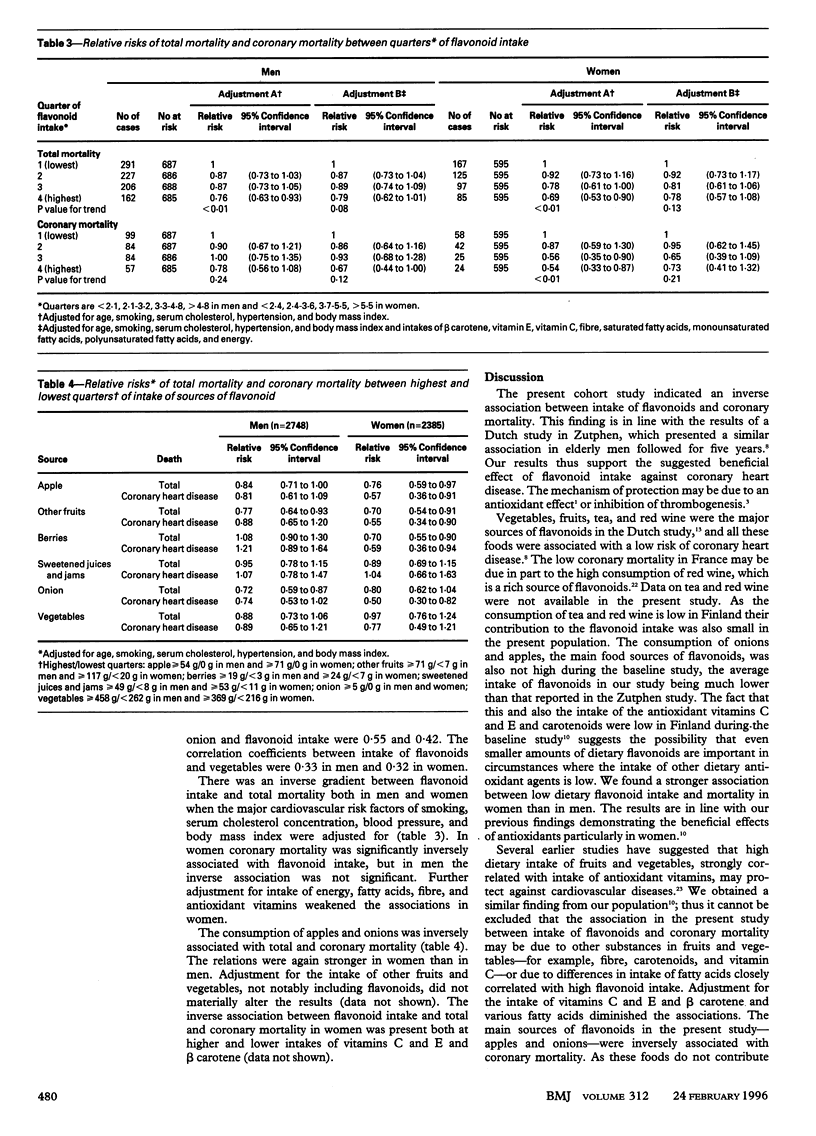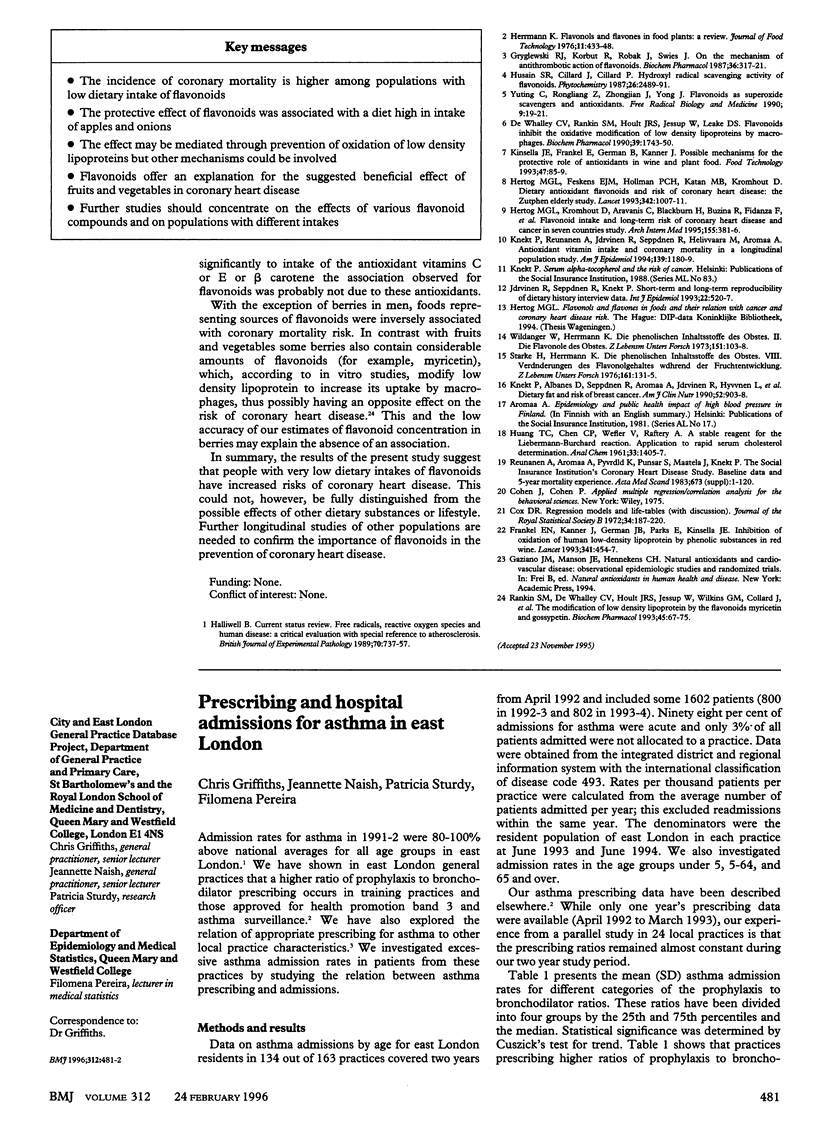Abstract
OBJECTIVE: To study the association between dietary intake of flavonoids and subsequent coronary mortality. DESIGN: A cohort study based on data collected at the Finnish mobile clinic health examination survey from 1967-72 and followed up until 1992. SETTINGS: 30 communities from different parts of Finland. SUBJECTS: 5133 Finnish men and women aged 30-69 years and free from heart disease at baseline. MAIN OUTCOME MEASURE: Dietary intake of flavonoids, total mortality, and coronary mortality. RESULTS: In women a significant inverse gradient was observed between dietary intake of flavonoids and total and coronary mortality. The relative risks between highest and lowest quarters of flavonoid intake adjusted for age, smoking, serum cholesterol concentration, blood pressure, and body mass index were 0.69 (95% confidence interval 0.53 to 0.90) and 0.54 (0.33 to 0.87) for total and coronary mortality, respectively. The corresponding values for men were 0.76 (0.63 to 0.93) and 0.78 (0.56 to 1.08), respectively. Adjustment for intake of antioxidant vitamins and fatty acids weakened the associations for women; the relative risks for coronary heart disease were 0.73 (0.41 to 1.32) and 0.67 (0.44 to 1.00) in women and men, respectively. Intakes of onions and apples, the main dietary sources of flavonoids, presented similar associations. The relative risks for coronary mortality between highest and lowest quarters of apple intake were 0.57 (0.36 to 0.91) and 0.81 (0.61 to 1.09) for women and men, respectively. The corresponding values for onions were 0.50 (0.30 to 0.82) and 0.74 (0.53 to 1.02), respectively. CONCLUSIONS: The results suggest that people with very low intakes of flavonoids have higher risks of coronary disease.
Full text
PDF



Selected References
These references are in PubMed. This may not be the complete list of references from this article.
- Chen Y. T., Zheng R. L., Jia Z. J., Ju Y. Flavonoids as superoxide scavengers and antioxidants. Free Radic Biol Med. 1990;9(1):19–21. doi: 10.1016/0891-5849(90)90045-k. [DOI] [PubMed] [Google Scholar]
- Frankel E. N., Kanner J., German J. B., Parks E., Kinsella J. E. Inhibition of oxidation of human low-density lipoprotein by phenolic substances in red wine. Lancet. 1993 Feb 20;341(8843):454–457. doi: 10.1016/0140-6736(93)90206-v. [DOI] [PubMed] [Google Scholar]
- Gryglewski R. J., Korbut R., Robak J., Swies J. On the mechanism of antithrombotic action of flavonoids. Biochem Pharmacol. 1987 Feb 1;36(3):317–322. doi: 10.1016/0006-2952(87)90288-7. [DOI] [PubMed] [Google Scholar]
- Hertog M. G., Feskens E. J., Hollman P. C., Katan M. B., Kromhout D. Dietary antioxidant flavonoids and risk of coronary heart disease: the Zutphen Elderly Study. Lancet. 1993 Oct 23;342(8878):1007–1011. doi: 10.1016/0140-6736(93)92876-u. [DOI] [PubMed] [Google Scholar]
- Hertog M. G., Kromhout D., Aravanis C., Blackburn H., Buzina R., Fidanza F., Giampaoli S., Jansen A., Menotti A., Nedeljkovic S. Flavonoid intake and long-term risk of coronary heart disease and cancer in the seven countries study. Arch Intern Med. 1995 Feb 27;155(4):381–386. [PubMed] [Google Scholar]
- Husain A., Bumpus F. M., De Silva P., Speth R. C. Localization of angiotensin II receptors in ovarian follicles and the identification of angiotensin II in rat ovaries. Proc Natl Acad Sci U S A. 1987 Apr;84(8):2489–2493. doi: 10.1073/pnas.84.8.2489. [DOI] [PMC free article] [PubMed] [Google Scholar]
- Knekt P., Albanes D., Seppänen R., Aromaa A., Järvinen R., Hyvönen L., Teppo L., Pukkala E. Dietary fat and risk of breast cancer. Am J Clin Nutr. 1990 Nov;52(5):903–908. doi: 10.1093/ajcn/52.5.903. [DOI] [PubMed] [Google Scholar]
- Rankin S. M., de Whalley C. V., Hoult J. R., Jessup W., Wilkins G. M., Collard J., Leake D. S. The modification of low density lipoprotein by the flavonoids myricetin and gossypetin. Biochem Pharmacol. 1993 Jan 7;45(1):67–75. doi: 10.1016/0006-2952(93)90378-a. [DOI] [PubMed] [Google Scholar]
- Reunanen A., Aromaa A., Pyörälä K., Punsar S., Maatela J., Knekt P. The Social Insurance Institution's coronary heart disease study. Baseline data and 5-year mortality experience. Acta Med Scand Suppl. 1983;673:1–120. [PubMed] [Google Scholar]
- Starke H., Herrmann K. Die phenolischen Inhaltsstoffe des Obstes. VIII. Veränderungen des Flavonolgehaltes während der Fruchtentwicklung. Z Lebensm Unters Forsch. 1976;161(2):131–135. doi: 10.1007/BF01112856. [DOI] [PubMed] [Google Scholar]
- de Whalley C. V., Rankin S. M., Hoult J. R., Jessup W., Leake D. S. Flavonoids inhibit the oxidative modification of low density lipoproteins by macrophages. Biochem Pharmacol. 1990 Jun 1;39(11):1743–1750. doi: 10.1016/0006-2952(90)90120-a. [DOI] [PubMed] [Google Scholar]


